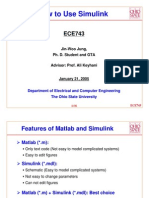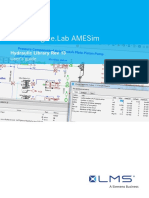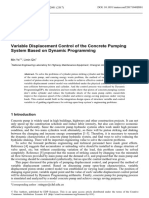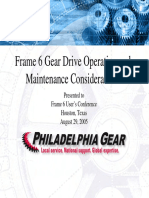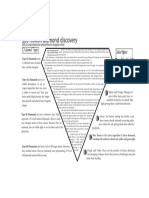Flow Control
Flow Control
Uploaded by
Guilherme PagatiniCopyright:
Available Formats
Flow Control
Flow Control
Uploaded by
Guilherme PagatiniOriginal Description:
Copyright
Available Formats
Share this document
Did you find this document useful?
Is this content inappropriate?
Copyright:
Available Formats
Flow Control
Flow Control
Uploaded by
Guilherme PagatiniCopyright:
Available Formats
Simulation of the flow control of radial piston
pump based on simulink
Qiu Xinguo , Chen Libin, Jiang Wei
Key Laboratory of E&M (Zhejiang University of Technology), Ministry of Education & Zhejiang Province
Zhejiang University of Technology
Hangzhou, China
e-mail: c_libin@yahoo.com
AbstractThe flow control of radial piston is widely used in Where: K q is the flow gain of servo valve, K c is the
speed, position servo system. In this paper the mathematic
model of the test radial piston pump is established and the pressure coefficient, xv , PL1 is the hydraulic cylinder
simulation diagram is established in the simulink of MATLAB.
Then the response curves of the system are achieved. The load pressure.
performance of the system is improved after adding the fuzzy- According to flow theorem, the continuity equation for
PID controller. compressible fluids:
dV V dP
Keywords-pump; valve; simulink; fuzzy-PID
Q -Q = dt + dt
r c (2)
Where: Q is the total flow get into
I. INTRODUCTION
r the control
Radial piston pump has high performance of high control
precision, impact resistance, low noise, long life and large chamber, Q is the total flow get out of
c the control
range of pressure adjustment. It is favored by domestic and
foreign pump industry. Radial piston is widely used in the chamber, V is the volume of control chamber, is the
mine, forging, injection molding, ship building, heavy elastic modulus of the effective volume.
machinery and other equipments. The flow control of Radial So the continuity equation of the hydraulic cylinders inlet
piston pump can be used for motor speed control, position oil chamber:
control and constant power control[1].
dV1 V1 dP1
Q L -k ic (P1 -P2 )-k ec P1 = + (3)
II. MATHEMATICAL MODEL OF HYDRAULIC CYLINDER dt dt
The variable pump control system of this paper is valve Similarly the oil chamber continuity equation:
controlled cylinder[2]. The simple diagram of electro- dV2 V2 dP2
hydraulic proportional directional control valve piston kic (P2 -P1 )-kecP2 -Q2 = + (4)
cylinder, seem in Fig.1. dt dt
Where: k ic is the external leakage coefficient of the
hydraulic cylinder, k ec is internal leakage coefficient of
FL hydraulic cylinder, V1 is the oil inlet chamber volume of
hydraulic cylinder, V2 is the oil outlet chamber volume of
hydraulic cylinder.
Suppose the piston is in the center:
Q1 +Q 2
QL =
2
dx L V dPL1 (5)
Q L =k tc PL + A L1 +
Ps T dt 4 dt
Figure 1. The simple diagram of electro-hydraulic proportional directional
control valve piston cylinder
Where: k tc is the leakage coefficient of the hydraulic
According to known fluid mechanics[3]:
cylinder, A L1 is the Effective piston area.
QL = K q xv Kc PL1 (1)
978-1-4244-7941-2/10/$26.00 2010 IEEE
Hydraulic cylinder force balance equation can be obtained q = 2 M Ae (9)
by force balance principle[4]. Suppose the pump speed N, theoretical average output flow
of the pump can be drawn:
d2 x L dx
AL1PL1 =M1 +B1 L +K1x L +FL1 (6)
dt 2
dt 2 AMN
QS = e (10)
60
Where: M1 is the load mass, B1 is the viscosity damping 2 AMN , so Q = K e .
Letbe K Q = s Q
coefficient of piston and load, K1 is the spring coefficient of 60
load, FL1 is the external force load on the piston. Last equation shows that theoretical average output flow
has a linear relationship with eccentricity.
The output force of cylinder loads on the stator of radial
piston [5]. The forces load on stator can be seen in Fig.2. As The transfer function between input voltage ui and flow is
asymmetric pump structure, the stress on stator is not balanced. shown in Fig.4.
The equilibrium equation of the stator:
QL
O1
KQ
K C1
A1
M 2s 2 +B2s+K 2
M1s 2 +B1s+K1
1
PL P1
FL
Aps
Figure 2. The forces load on the stator
Ap
FL1 = kh FL 2 + kv f FL 2 sign(Y ) +
PL
s
(7)
4
Vt
M 2Y + B2Y + K sY
K q + kec +
1
AL
Where: kh is average pressure coefficient, FL 2 is the
K qx
force of the single boot piston,kv is the average vertical
xv
pressure coefficient, f is friction coefficient, Y is
displacement and eccentricity of stator, B is the motion K
damping.
ui
Simultaneous equation (6) and equation (7) and las
transformed: Figure 4. The transfer function between input voltage ui
PL 1 A p = M Ys 2 + B Ys + K s + Different response of the step input at the different load
(8)
conditions are shown in the Fig. 5.
F L 2 ( k h + k v fsig n (Y ))
Pump flow can be achieved by accumulating the product of
all piston area and the speed. Study the movement of a single
plunger, and calculate its velocity. The plunger movement
diagram is shown in Fig.3.
Figure 3. The movement of a single plunger
The displacement one plunger displacement for one
rotation is 2eA. So M plungers displacement for one rotation Figure 5. The response of step input
is:
In the Fig.5, Curve 1 stands for the load 10MPa, Curve 2
stands for the load 20MPa and Curve 3 stands for the load
30MPa.
In the Fig.5, the adjustment time of step input is about
0.35s. With the increasing load, the system response time will
increase too. The overshoot of the flow is 20cm3, the peak time
of the system is about 0.24s, and the rise time of the system is Figure 8. Fuzzy PID simulation diagram
0.20s. Put the step signal to the system with fuzzy PID controller,
The response of ramp input at the no-load load state is compare the output response to the output of original system.
shown in the Fig. 6. The contrast is shown in Fig.9.
Figure 9. The contrast between the system with and without fuzzy-PID
Figure 6. The response of step input controller
In the Fig.6, curve 1 stands for the expected curve, Curve 2 By the Fig.9 can be seem, the response time reduces from
stands for the actual response curve. The steady-state error 0.25s to 0.1s, and the overshoot reduces a lot by adding fuzzy
exists when the input signal is ramp. PID controller.
III. FUZZY PID CONTROLLER DESIGN IV. CONCLUSION
Conventional PID control algorithm is difficult to achieve The flow control curve of system can achieve by
effective control because of the time-varying, nonlinear and establishing the mathematical model and simulation,
uncertain factors of hydraulic system. Fuzzy control and PID simulation results prove the flow control system is stable. The
control is combined in this paper to control the flow[6]. system characteristics can significantly improve by using fuzzy
The fuzzy controller of flow control system is shown in PID controller.
Fig.7.The fuzzy controller on-line adjust the parameters of PID
parameters according to the size, direction and trend of error REFERENCES
e[7], making the system perform much better. [1] S.R.Lee, K.Srinivation, Self-Tuning Control Application to Closed-loop
Servo-hydraulic Material test[j] ASEM Trans. of Journal of Dynamic
Systems Measurement and Control1990(112):880-888
[2] Ivantysynova M., et al. Prediction of swash plate moment using the
simulation tool CASPAR [A]. ASME International Mechanical Engineering
Congress[C]. New Orleans: IMECE 2002, 39322.
[3] Manring, N. D., and R. E. Johnson, Optimal orifice geometry for a
hydraulic pressure-reducing valve [J]. ASME Journal of Dynamic Systems,
Measurement, and Control, 1997, 119(9): 467-473.
[4] N.D. Nanring, etcModeling and Designing a Variable-Displacement
Open- Loop PumpASME Journal of Dynamic Systems, Measurement and
Control VOL.118, JUNE, 1996.
[5] K.A. Edge, etc, The Pumping Dynamics of Swash Plate Piston Pumps
ASME Journal of Dynamic Systems, Measurement and Control VOL.111,D
ESEMBER, 1989 .
Figure 7. The diagram of Fuzzy PID control principle [6] Woo Zhi-Wei, Chung Hung-Yuan etc, PID Type Fuzzy Controller with
Set the fuzzy controller discussed above in the simulink, Self-tuning Scaling Factors[J] Fuzzy Sets and Systems, 2000, 115(2):321
the established fuzzy PID simulation diagram is shown in [7] Junpeng shao Lihua Chen Zhibin sun The application of fuzzy
Fig.8. control strategy in electro-hydraulic servo system[C] Mechatronics and
Automation2005 lEEE International Conference,2010-2016,Vol.4
You might also like
- Kourio Hacks Cheats ScriptDocument51 pagesKourio Hacks Cheats Scriptivanmihnenko09No ratings yet
- Task 1 - Power Source Unit Implementation You Are A...Document3 pagesTask 1 - Power Source Unit Implementation You Are A...Zulqarnain KhanNo ratings yet
- Basic Mechanics Laminated Plates - NASADocument103 pagesBasic Mechanics Laminated Plates - NASAkiraakrNo ratings yet
- Chapter 6 PerformanceDocument111 pagesChapter 6 PerformanceLenh Nguyen0% (1)
- Photo 101 - Basic Photography and CompositionDocument71 pagesPhoto 101 - Basic Photography and CompositionJosh Aquino100% (1)
- Chemistry Lab1 PDF - 06-13Document11 pagesChemistry Lab1 PDF - 06-13cagdianad Dj100% (2)
- The Invisalign Appliance Today A Thinking Person S Orthodontic Appliance 2017 Seminars in OrthodonticsDocument53 pagesThe Invisalign Appliance Today A Thinking Person S Orthodontic Appliance 2017 Seminars in Orthodonticsdruzair007No ratings yet
- Modelling and Simulation of Mechatronic SystemsDocument37 pagesModelling and Simulation of Mechatronic SystemsEnes Umur GökçekNo ratings yet
- Hydraulic and Pneumatic Systems by Batch1 17M101,102,107,108,109,110Document49 pagesHydraulic and Pneumatic Systems by Batch1 17M101,102,107,108,109,110Agash ChellappaNo ratings yet
- Exp-6 Speed Control of Induction Motor Drive Using Closed Loop Vbyf Control in MATLAB Simulink.Document6 pagesExp-6 Speed Control of Induction Motor Drive Using Closed Loop Vbyf Control in MATLAB Simulink.Faijal MalekNo ratings yet
- Experiment No: 2: AIM: To Study and Simulate Single Phase Semi Control of DC Separately Excited MotorDocument29 pagesExperiment No: 2: AIM: To Study and Simulate Single Phase Semi Control of DC Separately Excited MotorPratik K AnandparaNo ratings yet
- Le Van Sy PHD Thesis PDFDocument205 pagesLe Van Sy PHD Thesis PDFNhan LeNo ratings yet
- Simscape Fluids Exercise 2018 ADocument15 pagesSimscape Fluids Exercise 2018 AElias BerbettyNo ratings yet
- Dynamic Analysis of Hydraulic DrivesDocument50 pagesDynamic Analysis of Hydraulic DrivesAnonymous Hy5Ir9QXNo ratings yet
- Thesis WTDocument94 pagesThesis WTSyed Wajahat AliNo ratings yet
- A. Alexakis PHD Thesis - FINALDocument438 pagesA. Alexakis PHD Thesis - FINALdodikNo ratings yet
- Pendulum SimulinkDocument10 pagesPendulum SimulinkSatyavir YadavNo ratings yet
- Thesis On Inverter Motor ControlDocument53 pagesThesis On Inverter Motor ControlSyed RafiNo ratings yet
- CH 21 AnswersDocument26 pagesCH 21 AnswersArjav Desai100% (1)
- Pneumatics NotesDocument91 pagesPneumatics NotesHafiezul Hassan0% (1)
- Introduction To Control SystemDocument51 pagesIntroduction To Control SystemNorkarlina Binti Khairul AriffinNo ratings yet
- MechatronicsLecture20202021 230930 163506Document185 pagesMechatronicsLecture20202021 230930 163506elhammanysoundousNo ratings yet
- Optimal and Robust ControlDocument216 pagesOptimal and Robust ControlCh BarriosNo ratings yet
- Working With Water Flow SensorsDocument9 pagesWorking With Water Flow SensorshuyenthaigiaNo ratings yet
- HB100 Hydraulics BenchDocument13 pagesHB100 Hydraulics BenchAira Joyce SalazarNo ratings yet
- SR-D100 User's Manual - E PDFDocument138 pagesSR-D100 User's Manual - E PDFRLome RicardoNo ratings yet
- Control of Compressor Surge With Active Magnetic BearingsDocument6 pagesControl of Compressor Surge With Active Magnetic BearingsVu MinhNo ratings yet
- Coupled Tank (Task)Document17 pagesCoupled Tank (Task)Anaya KhanNo ratings yet
- Hydraulic Power Control and AnalysisDocument170 pagesHydraulic Power Control and AnalysisKrishna Mohan SinghNo ratings yet
- Simulink Yaw Damping ModelDocument71 pagesSimulink Yaw Damping ModelDarryn FrerichsNo ratings yet
- Creating and Simulating A Simple Hydraulic Model - MATLAB & SimulinkDocument13 pagesCreating and Simulating A Simple Hydraulic Model - MATLAB & SimulinkShakeel AhmadNo ratings yet
- Fluid Mechanics and Hydraulic Machines (3141906)Document171 pagesFluid Mechanics and Hydraulic Machines (3141906)sp2532658.1970No ratings yet
- Project Report On Speed Control of DC Motor by Using PWM Technique 4Document76 pagesProject Report On Speed Control of DC Motor by Using PWM Technique 4Vishal SharmaNo ratings yet
- Muvengei, O.mutuku - Msc.mechanical Engineering.2008Document185 pagesMuvengei, O.mutuku - Msc.mechanical Engineering.2008Mạnh TuấnNo ratings yet
- Artificial Feel AircraftDocument8 pagesArtificial Feel Aircraftashnek100% (1)
- Parker Jet-Pipe Servovalves: Care and Handling GuideDocument9 pagesParker Jet-Pipe Servovalves: Care and Handling Guidebbkkss2No ratings yet
- Automatic Control of Hydraulic Machine Using PLCDocument5 pagesAutomatic Control of Hydraulic Machine Using PLCIJSTENo ratings yet
- DASBAENFTP62UDocument540 pagesDASBAENFTP62UAlexandre MarchioteNo ratings yet
- ElectroHydraulics Exercise (Basic)Document157 pagesElectroHydraulics Exercise (Basic)Loforte Salomão RapoioNo ratings yet
- Normal ShocksDocument12 pagesNormal ShocksaeroacademicNo ratings yet
- Servomechanism For Steering of AntennaDocument6 pagesServomechanism For Steering of AntennaAnastasia NapitupuluNo ratings yet
- Automated Hydraulic Control SystemsDocument23 pagesAutomated Hydraulic Control SystemshamidouNo ratings yet
- Tutorial On PLS and PCADocument17 pagesTutorial On PLS and PCAElsa George100% (1)
- SimulinkDocument36 pagesSimulinkloreggjuc3mNo ratings yet
- Lib HydraulicDocument72 pagesLib HydraulicD'Armi StefanoNo ratings yet
- (Davidson-2017) - Fluid Mechanics, Turbulent Flow and Turbulence ModelingDocument368 pages(Davidson-2017) - Fluid Mechanics, Turbulent Flow and Turbulence ModelingRenatoNo ratings yet
- Scilab PDFDocument27 pagesScilab PDFShreeyansh BhardwajNo ratings yet
- Pneumatics ElectropneumaticsDocument44 pagesPneumatics ElectropneumaticswanNo ratings yet
- تجارب مخبر الهيدروليك طالبDocument150 pagesتجارب مخبر الهيدروليك طالبjndalyfrasNo ratings yet
- Coupled Tank - MPCDocument6 pagesCoupled Tank - MPCMutiara PurnamaNo ratings yet
- Lab Report 2: BTM 2243 Fluid Power TechnologyDocument5 pagesLab Report 2: BTM 2243 Fluid Power TechnologyIbrahim AdhamNo ratings yet
- L-12 (SS) (Ia&c) ( (Ee) Nptel) - P-I-D ControlDocument10 pagesL-12 (SS) (Ia&c) ( (Ee) Nptel) - P-I-D ControlRaymond EsmeraldaNo ratings yet
- Automation and Robotics LabDocument38 pagesAutomation and Robotics LabRanjit KumarNo ratings yet
- Modeling and Control of An Acrobot Using MATLAB and SimulinkDocument4 pagesModeling and Control of An Acrobot Using MATLAB and SimulinkridhoNo ratings yet
- CS Lecture Notes Units 1 2 3Document88 pagesCS Lecture Notes Units 1 2 3sushinkNo ratings yet
- Notice of RetractionDocument5 pagesNotice of RetractionErna UtamiNo ratings yet
- Variable Displacement Control of The Concrete Pumping System Based On Dynamic ProgrammingDocument6 pagesVariable Displacement Control of The Concrete Pumping System Based On Dynamic ProgrammingKumardasNsNo ratings yet
- Centrifugal PumpsDocument105 pagesCentrifugal PumpsMohamed Moataz100% (2)
- Research Article: Nonlinear Dynamic Model-Based Adaptive Control of A Solenoid-Valve SystemDocument14 pagesResearch Article: Nonlinear Dynamic Model-Based Adaptive Control of A Solenoid-Valve SystemArrow96No ratings yet
- A Hydraulic Steering Gear Simulator For Analysis and ControlDocument9 pagesA Hydraulic Steering Gear Simulator For Analysis and Controlaj310790No ratings yet
- Thermo CribDocument1 pageThermo CribseamesbNo ratings yet
- Iahr WG1 2001Document13 pagesIahr WG1 2001Suresh CNo ratings yet
- Fast-Scale Bifurcation in Power-Factor-Correction Buck-Boost Converters and Eects of Incompatible PeriodicitiesDocument14 pagesFast-Scale Bifurcation in Power-Factor-Correction Buck-Boost Converters and Eects of Incompatible PeriodicitieshakikNo ratings yet
- This Ain't Your Dose: Sensor Spoofing Attack On Medical Infusion PumpDocument11 pagesThis Ain't Your Dose: Sensor Spoofing Attack On Medical Infusion PumpGuilherme PagatiniNo ratings yet
- Human Reliability Assessment Ofr Medical DevicesDocument9 pagesHuman Reliability Assessment Ofr Medical DevicesGuilherme PagatiniNo ratings yet
- Design and Development Drop: of A Unique Sensing Unit For Infusion PumpDocument4 pagesDesign and Development Drop: of A Unique Sensing Unit For Infusion PumpGuilherme PagatiniNo ratings yet
- Steel Trademark Enviada DengDocument2 pagesSteel Trademark Enviada DengGuilherme PagatiniNo ratings yet
- Exp 7b PDFDocument9 pagesExp 7b PDFAngelo Von N. AdiaoNo ratings yet
- Contrabalance Walvoil CC10ADocument3 pagesContrabalance Walvoil CC10AMatias Oñate ArriagadaNo ratings yet
- CH 11 Problems 5th EditionDocument3 pagesCH 11 Problems 5th Editionnisannn0% (1)
- AQA GCSE Physics: Higher: Advance Information of Assessed Content 2022Document11 pagesAQA GCSE Physics: Higher: Advance Information of Assessed Content 2022Will ShuteNo ratings yet
- Phys 371: Materials Physics Introduction To Materials Science)Document29 pagesPhys 371: Materials Physics Introduction To Materials Science)Mahmood AlqudimatNo ratings yet
- KIMRAY ValveDocument16 pagesKIMRAY ValveDenny Iskandar 'S-chuck'No ratings yet
- An Introduction To Wildlife Sound RecordingDocument29 pagesAn Introduction To Wildlife Sound Recordingiraigne100% (1)
- MSDS 134aDocument7 pagesMSDS 134aGamaliel Efren Santibañez RomeroNo ratings yet
- Experimental Investigation On A Two-Part Underwater Towed SystemDocument16 pagesExperimental Investigation On A Two-Part Underwater Towed SysteminaatNo ratings yet
- WWW SefindiaDocument11 pagesWWW SefindiaSUSHANTBIJAMNo ratings yet
- 05 PresbyopiaDocument48 pages05 PresbyopiaAzmaNo ratings yet
- Accessory and Load Gearbox ProblemsDocument36 pagesAccessory and Load Gearbox ProblemsJJ100% (2)
- ULTRADUR B4300G6 (03p023)Document3 pagesULTRADUR B4300G6 (03p023)ayala castroNo ratings yet
- Forms of Potential EnergyDocument10 pagesForms of Potential EnergyRinmie Jalandoon RagudoNo ratings yet
- Nanocomposite PDFDocument16 pagesNanocomposite PDFRahul YadavNo ratings yet
- Flightsafety 510 SchematicDocument86 pagesFlightsafety 510 Schematictinpena100% (1)
- 07 - PLMGS - 4e - Emp1 16-7Document17 pages07 - PLMGS - 4e - Emp1 16-7haiz.bnNo ratings yet
- Boundary Conditions For Gas Rate and Bubble Size at The Pulp-Froth Interface in Flotation EquipmentDocument4 pagesBoundary Conditions For Gas Rate and Bubble Size at The Pulp-Froth Interface in Flotation EquipmentJose Luis Barrientos RiosNo ratings yet
- KPSVDDocument6 pagesKPSVDBrian KrouseNo ratings yet
- THKDocument1,901 pagesTHKapi-26356646No ratings yet
- GGH1501 Learning Unit 2Document51 pagesGGH1501 Learning Unit 2SiyathokozaNo ratings yet
- Modern Physics Chapter 5 (Physics)Document43 pagesModern Physics Chapter 5 (Physics)biniyam kefyalewNo ratings yet
- Study of Residual Life Prediction and Maintenance Decision-Making of Portal CraneDocument4 pagesStudy of Residual Life Prediction and Maintenance Decision-Making of Portal CraneMohamed AhmadNo ratings yet
- Lecture 1 - Properties of Concrete & SteelDocument30 pagesLecture 1 - Properties of Concrete & SteelFayez MoutassemNo ratings yet
- Monitoring Ug Geotech PtfiDocument32 pagesMonitoring Ug Geotech Ptfimaruko100% (2)
- DimondDocument1 pageDimondapi-318888783No ratings yet











































